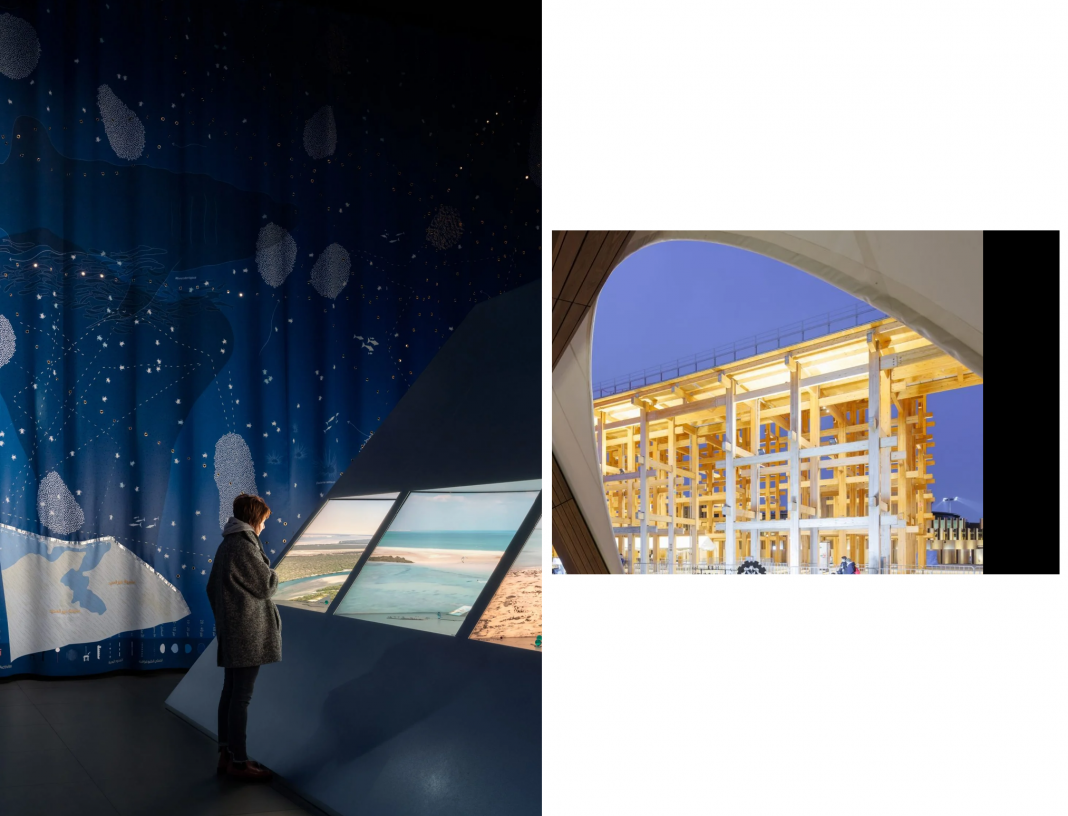Inspired by the curves of traditional dhow sails and built with a fusion of Japanese and Qatari craftsmanship, the Qatar Pavilion by Kengo Kuma and Associates at Expo 2025 Osaka is a fluid meditation on coastal identity, architectural storytelling and national culture. At the heart of Expo 2025 Osaka, set against the rhythmic forms of a massive wooden ring designed by Sou Fujimoto Architects, stands the Qatar Pavilion—an elegant, sail-like structure that seems to shift with the breeze. Designed by the globally renowned Kengo Kuma and Associates, the pavilion is a sculptural tribute to the sea, memory and migration. It is as much a feat of architecture as it is a cultural statement—one that captures Qatar’s history, economy, and spirit through the enduring symbol of the dhow.

Architecture inspired by the sea
Kengo Kuma’s concept draws heavily on the traditional Qatari dhow—a wooden sailing vessel that once dominated trade and pearling routes in the Arabian Gulf. The pavilion’s timber structure uses advanced joinery techniques from both Japanese and Qatari traditions, creating a poetic bridge between two coastal cultures.
Scalloped curves in the architecture mirror the gentle undulations of sails catching the wind. White fabric is stretched across arched timber frames, creating both enclosure and permeability and providing dynamic shadows that shift with the sun. These forms invite visitors to meander through a light-filled perimeter walkway, where glimpses of the structure’s inner sanctum are slowly revealed through arched openings.
Kuma’s architectural language, known for merging nature and built form, feels particularly resonant here. In the Qatar Pavilion, fabric and timber are not only materials—they’re metaphors. They embody the interplay between permanence and impermanence, tradition and innovation and east and west.

From coastline to culture
Within the pavilion, visitors encounter a multi-sensory exhibition designed by AMO, the research and design arm of Dutch architecture powerhouse OMA. Titled From the Coastline We Progress, the installation explores the profound role Qatar’s coastline has played in shaping the nation’s identity, economy, and heritage. “We chose to tell the story of Qatar through its coastline,”explained AMO director Samir Bantal. “It’s where the country’s first encounters happened—where people arrived and departed. It’s where the culture of fishing and pearling was born, and where 99 percent of the population still lives and works today.”
The exhibition is divided into 12 zones, each exploring different facets of coastal life. A central highlight is the Sea Curtain, a fabric-lined cinema space conceived in collaboration with Dutch landscape and interior design studio Inside Outside. The curtain is adorned with abstract patterns representing Qatar’s maritime boundaries, visually mapping a network of ecological and political complexity.
Inside, a triptych screen displays a film directed by AMO—offering cinematic glimpses into Qatar’s archaeological sites, natural reserves and coastal cities. More than a straightforward documentary, the film seeks to evoke a layered narrative of place, history, and transition.

A cinematic retreat in the dunes
One of the most evocative elements of the Qatar Pavilion is its central cinema space, nestled within a dune-like structure of curved partition walls. Inspired by Qatar’s traditional winter camps—where families retreat to the desert for quiet reflection, this interior environment is meant to contrast the bustling exterior experience of the expo. “The central space of the exhibition was inspired by the winter camps where many Qataris spend significant time away from the buzz of the city,” said Bantal. “In this geometric representation of the dunes, we created a cinema space, as a retreat from the many efforts of the coastline.”
These curved walls serve as both functional dividers and abstract representations of desert topography, reinforcing the exhibition’s grounding in natural forms. The layout offers a place of calm and contemplation, anchoring the broader experience in a moment of introspection.

Material craft and cultural convergence
A defining feature of the pavilion is its use of local craftsmanship and sustainable design strategies. The timber construction employs joinery techniques shared between Japanese and Qatari builders—symbolizing a respectful exchange of cultural knowledge. The decision to work with lightweight fabric and timber also reflects a commitment to environmental sensitivity, ensuring the pavilion is both durable and adaptable to Osaka’s seasonal climate.
The blend of materials and design languages is seamless. Where Japanese minimalism meets Arabian maritime heritage, the result is not a fusion for its own sake, but an architecture of resonance—one that feels rooted in place yet open to the world.

Context within Expo 2025
The Qatar Pavilion joins a rich tapestry of national exhibits at Expo 2025 Osaka, where themes of sustainability, cross-cultural exchange and future-facing design are prominent. It sits within a massive circular structure dubbed the world’s largest wooden building, designed by Sou Fujimoto Architects – a symbolic ring that connects the global narratives of participating nations.
Nearby, the Bahrain Pavilion by Lebanese architect Lina Ghotmeh also references traditional dhow boats, reinforcing the broader regional dialogue about seafaring heritage and architectural expression. These shared motifs reflect a deeper inquiry into the role of the ocean, not just as geography, but as memory, migration, and mythology.
A story told in sails
In the end, the Qatar Pavilion is more than an architectural icon—it’s a lyrical gesture toward a cultural legacy shaped by the sea. Through the vision of Kengo Kuma and the interpretive storytelling of AMO, the pavilion invites visitors to consider how history and environment intersect to form national identity.
In the soft tension between its fabric sails and wooden bones, between narrative film and quiet retreat, between Qatari coastline and Japanese craft, the Qatar Pavilion embodies the spirit of the expo itself: a place of wonder, of exchange and of progress shaped by tradition.



